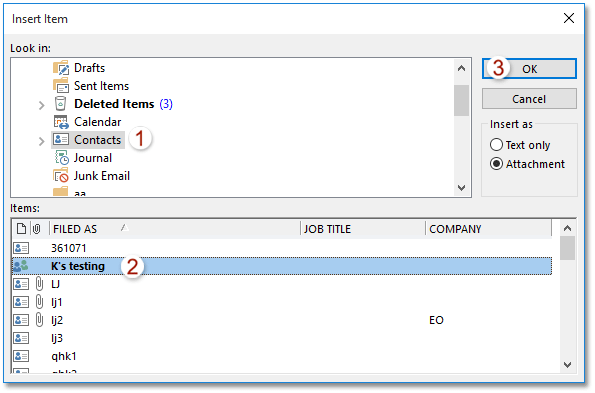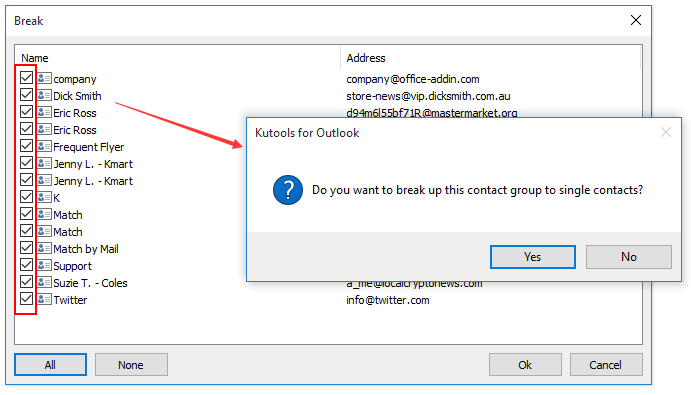Wie teilt man eine Kontaktgruppe (Verteilerliste) in Outlook?
Angenommen, Sie möchten Ihre Kontaktgruppen mit Ihren Kollegen teilen, wie könnten Sie dies tun? Und was ist, wenn Sie die Kontaktgruppen, die an Sie gesendet werden, in Outlook speichern möchten? Dieser Artikel behandelt das Teilen von Kontaktgruppen in Outlook.
- Teilen Sie Ihre Kontaktgruppen (Verteilerlisten) in Outlook mit anderen Benutzern
- Teilen/Speichern einer Kontaktgruppe (Verteilerliste), die Ihnen in Outlook gesendet wurde
Teilen Sie Ihre Kontaktgruppen (Verteilerlisten) in Outlook mit anderen Benutzern
Wenn Sie Ihre Kontaktgruppen in Outlook mit anderen teilen möchten, können Sie wie folgt vorgehen:
1. Klicken Sie in der Postansicht auf Start > Neue E-Mail, um eine neue E-Mail zu erstellen.
2. Klicken Sie im Fenster der neuen Nachricht auf Einfügen > Outlook-Element. Siehe Screenshot:

3. Gehen Sie im sich öffnenden Dialogfeld „Element einfügen“ wie folgt vor:
(1) Gehen Sie zu Suchen in und klicken Sie, um den Ordner Kontakte auszuwählen, der die Kontaktgruppen enthält, die Sie teilen möchten;
(2) Gehen Sie zu Elemente und klicken Sie, um eine oder mehrere Kontaktgruppen auszuwählen, die Sie teilen möchten;
(3) Klicken Sie auf die Schaltfläche OK . Siehe Screenshot:

4. Nun wurden die ausgewählten Kontaktgruppen als Anhänge zur neuen E-Mail hinzugefügt. Verfassen Sie die E-Mail und senden Sie sie ab.
Speichern Sie jedes Mitglied einer Kontaktgruppe (Verteilerliste) als individuellen Kontakt in Outlook
Mit der Funktion Trennen der Kontaktgruppe von Kutools für Outlook können Sie schnell alle oder mehrere ausgewählte Mitglieder als einzelne Kontakte in Outlook speichern.

Teilen/Speichern einer Kontaktgruppe (Verteilerliste), die Ihnen in Outlook gesendet wurde
Wenn Sie E-Mails mit freigegebenen Kontaktgruppen erhalten haben, können Sie die Kontaktgruppen ganz einfach in Ihren Kontakteordner in Outlook kopieren und speichern.
1. Klicken Sie in der Postansicht, um die E-Mail mit den Kontaktgruppenanlagen im Lesebereich zu öffnen.
2. Wählen Sie die Kontaktgruppen im Lesefenster, ziehen Sie diese zum Symbol „Personen“ ![]() oder
oder ![]() im Navigationsbereich und lassen Sie die Maustaste los, sobald sich der Cursor ändert in
im Navigationsbereich und lassen Sie die Maustaste los, sobald sich der Cursor ändert in![]() . Siehe Screenshot:
. Siehe Screenshot:

Bis hierhin wurden die angegebenen Kontaktgruppen, die andere mit Ihnen geteilt haben, in Ihren Kontakteordner kopiert und gespeichert.
Verwandte Artikel
Kontakte aus einer Verteilerliste (Kontaktgruppe) in Outlook hinzufügen
Mehrere E-Mail-Absender zu einer Verteilerliste (Kontaktgruppe) in Outlook hinzufügen
Verteilerliste (Kontaktgruppe) auf einer Seite in Outlook drucken
Beste Office-Produktivitätstools
Eilmeldung: Kutools für Outlook veröffentlicht kostenlose Version!
Erleben Sie das brandneue Kutools für Outlook mit über100 unglaublichen Funktionen! Jetzt herunterladen!
📧 E-Mail-Automatisierung: Automatische Antwort (verfügbar für POP und IMAP)/E-Mail senden planen/Automatische CC/BCC nach Regel beim Senden von E-Mail/Automatische Weiterleitung (Erweiterte Regeln) /Begrüßung automatisch hinzufügen/E-Mails mit mehreren Empfängern automatisch in einzelne E-Mails aufteilen...
📨 E-Mail-Management: E-Mail zurückrufen/Betrugs-E-Mails nach Betreff und anderen Kriterien blockieren/Duplikate löschen/Erweiterte Suche/Ordner organisieren...
📁 Anhänge Pro:Stapel speichern/Stapel ablösen/Stapel komprimieren/Automatisch speichern/Automatisch abtrennen/Automatische Komprimierung...
🌟 Interface-Magie: 😊Mehr schöne und coole Emojis /Benachrichtigung bei wichtigen E-Mails/Outlook minimieren statt schließen...
👍 Ein-Klick-Genies: Allen mit Anhängen antworten /Anti-Phishing-E-Mails/🕘Zeitzone des Absenders anzeigen...
👩🏼🤝👩🏻 Kontakte & Kalender: Stapel Kontakt aus ausgewählten E-Mails hinzufügen/Kontaktgruppe in einzelne Gruppen aufteilen/Geburtstagserinnerung entfernen...
Verwenden Sie Kutools in Ihrer bevorzugten Sprache – unterstützt Englisch, Spanisch, Deutsch, Französisch, Chinesisch und über40 weitere!


🚀 Ein-Klick-Download — alle Office-Add-Ins verfügbar
Dringend empfohlen: Kutools für Office (5-in-1)
Mit einem Klick laden Sie fünf Installationsprogramme gleichzeitig herunter — Kutools für Excel, Outlook, Word, PowerPoint und Office Tab Pro. Jetzt herunterladen!
- ✅ Ein-Klick-Komfort: Laden Sie alle fünf Installationspakete in nur einem Schritt herunter.
- 🚀 Für jede Office-Aufgabe bereit: Installieren Sie die benötigten Add-Ins genau dann, wenn Sie sie brauchen.
- 🧰 Enthalten: Kutools für Excel / Kutools für Outlook / Kutools für Word / Office Tab Pro / Kutools für PowerPoint